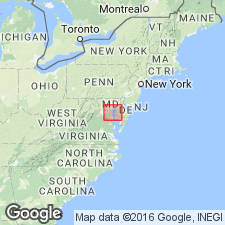
- Usage in publication:
-
- Paspotansa member, substage
- Modifications:
-
- Named
- Dominant lithology:
-
- Greensand
- Marl
- AAPG geologic province:
-
- Atlantic Coast basin
Summary:
Upper 10 to 17 ft of Paspotansa member (new name) at top of Aquia formation consists of thick-bedded layers and interstratified greensand marl. Lower 30 ft consists of light greenish-gray greensand. Overlies and is faunally separable from Piscataway member or substage. Assigned to Eocene.
Source: GNU records (USGS DDS-6; Reston GNULEX).
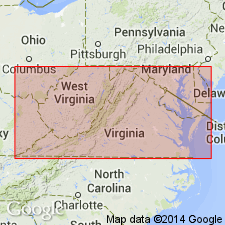
- Usage in publication:
-
- Paspotansa Member
- Modifications:
-
- Not used
- AAPG geologic province:
-
- Atlantic Coast basin
Summary:
Two members of the Aquia Formation, the Piscataway and the Paspotansa, were differentiated on the basis of their weathered appearance. The writer found that the Piscataway, at its type locality, is a yellowish-brown, glauconitic quartz sand--a color and lithology that Clark and Martin attributed to the Paspotansa. It is proposed here to drop the Piscataway and Paspotansa as Members of the Aquia as the basis upon which the units were defined is unreliable.
Source: GNU records (USGS DDS-6; Reston GNULEX).

- Usage in publication:
-
- Paspotansa Greensand Marl Member*
- Modifications:
-
- Age modified
- AAPG geologic province:
-
- Atlantic Coast basin
Summary:
Age of Aquia Formation and its two members changed from early Eocene to Paleocene.
Source: GNU records (USGS DDS-6; Reston GNULEX).
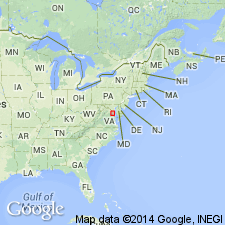
- Usage in publication:
-
- Paspotansa Member*
- Modifications:
-
- Revised
- AAPG geologic province:
-
- Atlantic Coast basin
Summary:
Names changed to Piscataway Member and Paspotansa Member of Aquia Formation.
Source: GNU records (USGS DDS-6; Reston GNULEX).
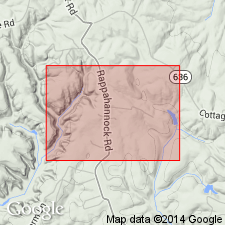
- Usage in publication:
-
- Paspotansa Member*
- Modifications:
-
- Age modified
- AAPG geologic province:
-
- Atlantic Coast basin
Summary:
Age changed from Paleocene to: late Paleocene.
Source: GNU records (USGS DDS-6; Reston GNULEX).
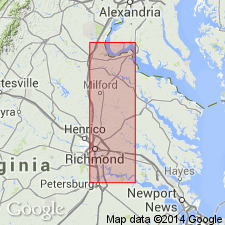
- Usage in publication:
-
- Paspotansa Member*
- Modifications:
-
- Principal reference
- Revised
- Biostratigraphic dating
- AAPG geologic province:
-
- Atlantic Coast basin
Summary:
Paspotansa Member revised to include "zones" 6 and 7 of Clark and Martin (1901), which were previously assigned to part of underlying Piscataway Member, because of significant lithology change between "zones" 5 and 6. Evidence from calcareous nannofossils (L.M. Bybell, 1984, oral commun.) and dinoflagellates (L.E. Edwards, 1984, oral commun.) indicates a biostratigraphic break which is further supported by mollusk data. Consists of fine to very fine, silty, well-sorted, micaceous, glauconitic and quartzose sand occurring massively or in thick beds. This texture differs from underlying poorly sorted, clayey, shelly, glauconitic and quartzose sands of Piscataway Member. Contact between members is apparently disconformable. Principal reference section (lectostratotype) is designated at USGS Locality 26332, right bank of Potomac River, 1.5 mi (2.4 km) below mouth of Aquia Creek and Youbedam Landing, Passapatanzy 7.5-minute quad, Stafford Co., VA. Contains mollusk TURRITELLA MORTONI at lectostratotype. Elsewhere, dominant fossils include TURRITELLA HUMEROSA, OSTREA SINUOSA, CRASSATELLITES ALAEFORMIS, and CUCULLAEA GIGANTEA. Forms closely related or identical to T. MORTONI are also found in upper Paleocene deposits at Wilsons Landing on Santee River, SC. T. PRAECINTA occurs with T. MORTONI at Wilsons Landing and has been reported from Tuscahoma Formation in GA by Gibson (1980). Both forms are found in AL ranging from Nanafalia Formation to Bells Landing Member of Tuscahoma. T. HUMEROSA also occurs in Nanafalia and Tuscahoma. OSTREA SINUOSA occurs in upper Paleocene beds in SC, GA, and AL. Gibson and others (1980) place all of Paspotansa Member in nannoplankton Zone NP 9 based on Oak Grove core analyses, Westmoreland Co., VA; L.M. Bybell (1984, oral commun.) concurs with this assignment.
Source: GNU records (USGS DDS-6; Reston GNULEX).
For more information, please contact Nancy Stamm, Geologic Names Committee Secretary.
Asterisk (*) indicates published by U.S. Geological Survey authors.
"No current usage" (†) implies that a name has been abandoned or has fallen into disuse. Former usage and, if known, replacement name given in parentheses ( ).
Slash (/) indicates name conflicts with nomenclatural guidelines (CSN, 1933; ACSN, 1961, 1970; NACSN, 1983, 2005, 2021). May be explained within brackets ([ ]).

